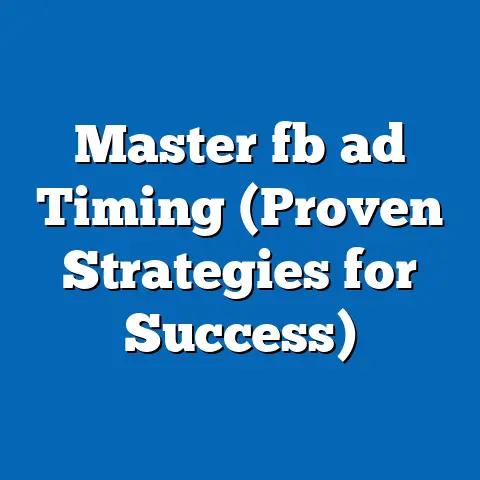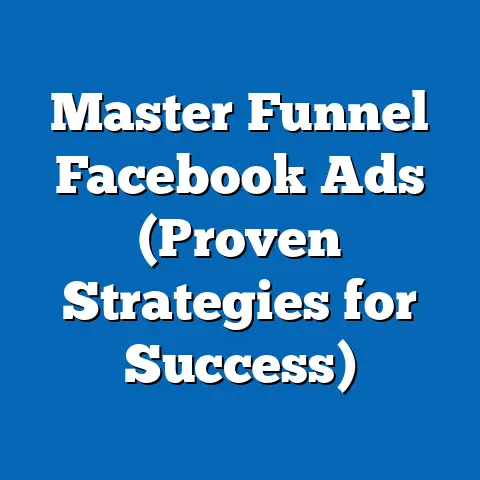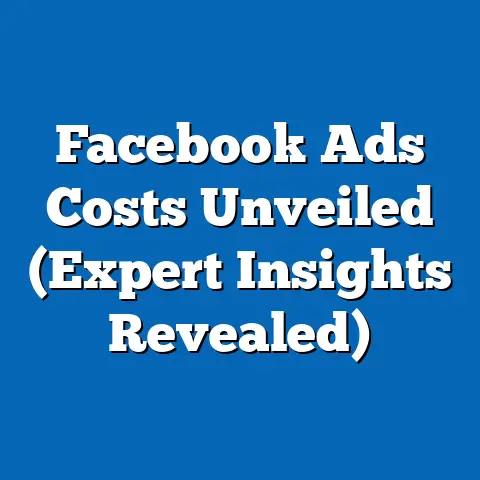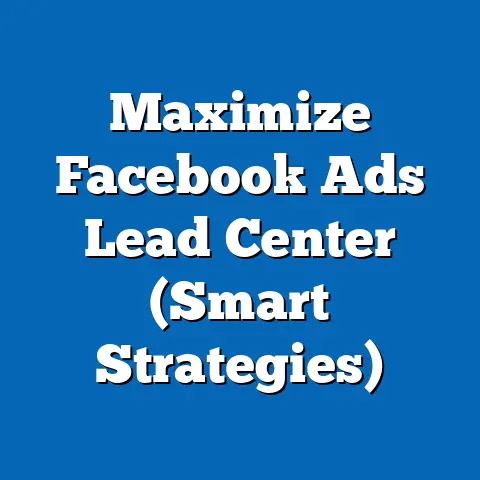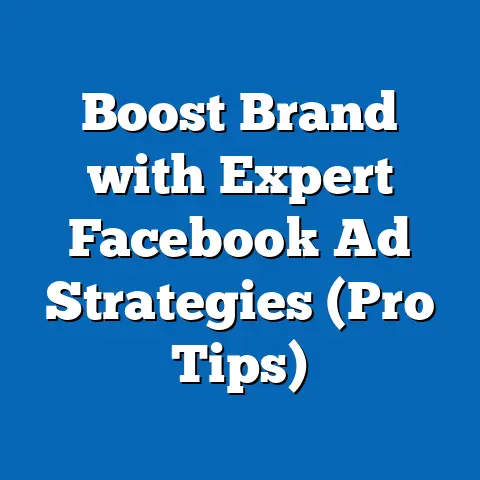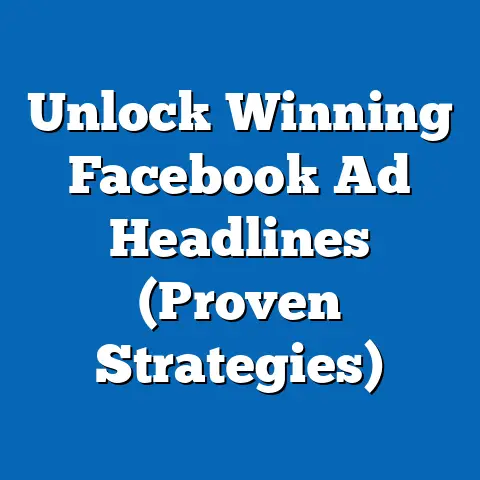Boost Ad Ranking on Facebook (Expert Strategies Revealed)
In the ever-evolving landscape of digital marketing, the concept of “Boost Ad Ranking” on platforms like Facebook has emerged as a game-changing idea that reshapes how businesses connect with their audiences. At its core, Boost Ad Ranking refers to the strategic optimization of paid advertisements on Facebook to improve their visibility, engagement, and overall performance within the platform’s algorithm-driven ad delivery system. This approach leverages data-driven techniques, creative innovation, and an in-depth understanding of user behavior to ensure ads reach the right audience at the right time, maximizing return on investment (ROI).
The defining characteristics of Boost Ad Ranking include its reliance on algorithmic alignment, audience targeting precision, and continuous performance monitoring. Unlike traditional advertising, where placement and reach were often static, this concept thrives on adaptability—adjusting in real-time to user interactions, platform updates, and competitive dynamics. Its historical context lies in the rapid growth of social media advertising since the early 2000s, particularly after Facebook introduced its advertising platform in 2007, which evolved into a sophisticated ecosystem driven by machine learning and big data.
Societally, Boost Ad Ranking has profound implications. It democratizes advertising by allowing small businesses to compete with larger corporations through smart, cost-effective strategies, while also raising concerns about data privacy, ad saturation, and the ethical use of targeted messaging. As we delve into this comprehensive analysis, we will explore the mechanisms behind Boost Ad Ranking, historical milestones, expert strategies, and the broader impact on businesses and society.
By 2012, Facebook had rolled out its News Feed ads, a pivotal shift that integrated advertisements directly into users’ social experiences. This move, coupled with the introduction of the Facebook Ads Manager, gave advertisers unprecedented control over campaign creation and targeting. The platform’s algorithm began prioritizing ads based on relevance and user engagement, laying the groundwork for what would later become Boost Ad Ranking.
The mid-2010s marked a turning point with the integration of machine learning into Facebook’s ad delivery system. The algorithm, often referred to as the “EdgeRank” in its early iterations, evolved into a complex model that factored in hundreds of variables, including user preferences, past interactions, and ad quality. According to a 2016 report by eMarketer, Facebook ad revenue surpassed $26 billion that year, reflecting its dominance in the digital advertising space.
This historical progression set the stage for Boost Ad Ranking, a concept that emerged as marketers sought to “game” the algorithm to achieve higher ad placements without exponentially increasing costs. The societal shift toward mobile-first content consumption, with over 80% of Facebook users accessing the platform via smartphones by 2019 (Statista), further amplified the importance of ranking optimization, as advertisers competed for limited screen real estate.
Defining Boost Ad Ranking: Core Mechanisms and Principles
Boost Ad Ranking is not an official term coined by Facebook but rather a strategic framework developed by digital marketing experts to describe the process of enhancing an ad’s performance within the platform’s auction-based delivery system. At its heart, this concept revolves around improving three key metrics: relevance score, estimated action rates, and ad quality. These metrics collectively determine an ad’s “total value” in the eyes of Facebook’s algorithm, influencing how often and to whom it is shown.
Relevance score, now integrated into broader ad quality diagnostics as of 2020, measures how well an ad resonates with its target audience based on engagement metrics like clicks, likes, and shares. Estimated action rates predict the likelihood of users taking the desired action (e.g., making a purchase or signing up for a newsletter) after seeing the ad. Ad quality assesses creative elements, such as image clarity, text readability, and overall user experience, ensuring that ads are not intrusive or misleading.
The principle behind Boost Ad Ranking is rooted in Facebook’s ad auction system, where advertisers bid for impressions and clicks, but the highest bidder doesn’t always win. Instead, the algorithm prioritizes ads with higher total value, balancing advertiser goals with user experience. A 2021 study by Hootsuite revealed that ads with high relevance and engagement could achieve up to 50% lower cost-per-click (CPC) compared to poorly optimized campaigns, underscoring the financial incentive for mastering this strategy.
Key Historical Events Shaping Ad Ranking Strategies
Several milestones in Facebook’s development have directly influenced the strategies behind Boost Ad Ranking. The 2013 introduction of the Relevance Score metric was a game-changer, as it provided advertisers with a tangible measure of how well their ads aligned with audience interests. This transparency pushed marketers to prioritize content quality over sheer volume, a trend that continues to define modern strategies.
In 2018, the Cambridge Analytica scandal brought intense scrutiny to Facebook’s data practices, prompting the platform to tighten privacy controls and reduce reliance on third-party data for targeting. Advertisers had to pivot toward first-party data and organic engagement, further emphasizing the need for high-quality, relevant ads to maintain ranking. The rollout of iOS 14’s App Tracking Transparency (ATT) feature in 2021, which limited cross-app tracking, dealt another blow to traditional targeting methods, forcing marketers to refine their Boost Ad Ranking tactics through contextual and interest-based targeting.
These events highlight a broader societal shift toward privacy and user empowerment, which has reshaped how advertisers approach ad optimization. As noted by digital marketing expert Neil Patel in a 2022 blog post, “The future of Facebook advertising isn’t about exploiting data; it’s about creating value for users through relevance and trust.” This perspective underscores the evolving ethical considerations tied to Boost Ad Ranking.
Expert Strategies for Boosting Ad Ranking on Facebook
With the foundational principles and historical context established, let’s explore actionable, expert-driven strategies for optimizing ad ranking on Facebook. These tactics are derived from industry best practices, case studies, and insights from leading digital marketers. While no single approach guarantees success due to the algorithm’s complexity, these strategies provide a robust framework for improving performance.
1. Prioritize Audience Relevance Through Micro-Targeting
One of the most effective ways to boost ad ranking is by ensuring that your content resonates deeply with a specific audience segment. Micro-targeting involves creating highly tailored audience groups based on demographics, interests, behaviors, and past interactions with your brand. For instance, instead of targeting “women aged 25-34,” a more effective approach might be “women aged 25-34 who have engaged with fitness content and live in urban areas.”
A 2020 case study by Social Media Examiner demonstrated that campaigns using micro-targeting saw a 30% increase in relevance scores and a 25% reduction in cost-per-acquisition (CPA). Tools like Facebook’s Audience Insights and Custom Audiences allow advertisers to refine their targeting, ensuring ads are shown to users most likely to engage. However, experts caution against overly narrow targeting, as it can limit reach and increase costs if not balanced with broader awareness campaigns.
2. Optimize Creative Elements for Engagement
Ad quality is a critical factor in ranking, and creative elements—such as visuals, copy, and calls-to-action (CTAs)—play a central role. High-quality images or videos that evoke emotion or tell a story tend to outperform generic stock content. According to a 2022 report by HubSpot, ads with video content achieved 48% higher engagement rates compared to static images.
Copywriting also matters: concise, action-oriented text with clear value propositions (e.g., “Save 20% Today!”) often drives higher click-through rates (CTR). A/B testing different creative variations is a recommended practice to identify what resonates best with your audience. Digital marketing consultant Amy Porterfield emphasizes, “Your ad isn’t just a pitch; it’s a conversation starter. Make it visually and emotionally compelling.”
3. Leverage Retargeting for Higher Relevance
Retargeting, or remarketing, involves showing ads to users who have previously interacted with your brand—whether by visiting your website, engaging with a post, or abandoning a cart. These users are already familiar with your business, making them more likely to convert, which boosts estimated action rates and overall ad ranking.
Facebook’s Pixel and Custom Audiences features enable precise retargeting campaigns. A 2021 study by WordStream found that retargeted ads on Facebook had a 70% higher conversion rate compared to cold audience campaigns. However, frequency capping is essential to avoid ad fatigue, where users become annoyed by seeing the same ad repeatedly.
4. Focus on Post-Click Experience
Facebook’s algorithm doesn’t just evaluate the ad itself; it also considers the user experience after they click. A slow-loading landing page, irrelevant content, or a complicated checkout process can negatively impact estimated action rates and long-term ad performance. Ensuring a seamless post-click experience—such as mobile-optimized pages and clear navigation—can significantly improve ranking.
For example, a 2019 experiment by Unbounce revealed that reducing landing page load time by just 1 second increased conversions by 7%. Experts recommend aligning the ad’s messaging with the landing page content to maintain consistency and trust, a practice often referred to as “message match.”
5. Monitor and Adapt to Algorithm Updates
Facebook’s algorithm is not static; it undergoes frequent updates that can alter how ads are ranked. Staying informed about these changes—through resources like Facebook’s Business Blog or industry newsletters—allows advertisers to adapt their strategies proactively. For instance, the 2023 shift toward prioritizing “meaningful interactions” over passive engagement (e.g., likes) prompted marketers to focus on ads that encourage comments and shares.
Continuous monitoring of campaign performance through tools like Ads Manager and third-party analytics platforms is also critical. As digital strategist Dennis Yu notes, “The algorithm rewards agility. If you’re not testing and iterating weekly, you’re falling behind.”
Societal and Economic Impacts of Boost Ad Ranking
The rise of Boost Ad Ranking as a dominant strategy in digital marketing has far-reaching implications for society, culture, and the economy. On one hand, it levels the playing field by enabling small businesses and entrepreneurs to reach targeted audiences with limited budgets. A 2022 survey by Statista found that 68% of small business owners in the U.S. relied on Facebook ads as their primary marketing channel, citing affordability and precision as key benefits.
On the other hand, the intense focus on algorithmic optimization raises ethical concerns. The ability to micro-target users based on personal data can lead to manipulative advertising practices, as seen in political campaigns during the 2016 U.S. election. Privacy advocates argue that Boost Ad Ranking strategies often exploit user information in ways that prioritize profit over consent, a debate that continues to shape regulatory frameworks like the European Union’s General Data Protection Regulation (GDPR).
Economically, the emphasis on ad ranking has contributed to Facebook’s parent company, Meta, generating over $114 billion in ad revenue in 2022 (Meta Annual Report). This financial success reflects the platform’s central role in global advertising, but it also fuels concerns about market concentration and the displacement of traditional media outlets. Culturally, the proliferation of highly targeted ads shapes consumer behavior, often reinforcing echo chambers by exposing users only to content that aligns with their existing beliefs.
Workplace Implications: Adapting to a Data-Driven Marketing Era
For marketing professionals and businesses, mastering Boost Ad Ranking is no longer optional—it’s a core competency in a data-driven era. The demand for skills in audience analytics, creative optimization, and algorithmic adaptation has reshaped job roles, with positions like “Facebook Ads Specialist” and “Digital Growth Hacker” becoming commonplace. A 2023 LinkedIn report highlighted that digital marketing roles saw a 25% year-over-year growth in demand, driven largely by the need for social media advertising expertise.
Companies are also restructuring their marketing teams to prioritize agility and cross-functional collaboration. For instance, integrating creative and data teams ensures that ad campaigns are both visually compelling and analytically sound. Training programs and certifications, such as Meta’s Blueprint courses, are increasingly popular for upskilling employees in ad ranking strategies.
However, this shift also introduces challenges. The pressure to continuously optimize can lead to burnout among marketers, while the reliance on algorithmic performance metrics may stifle creative risk-taking. Balancing innovation with data-driven decision-making remains a key tension for the industry.
Comparing Generational Approaches to Facebook Advertising
Generational differences play a significant role in how Boost Ad Ranking strategies are applied, as each cohort interacts with social media and advertising in unique ways. Millennials (born 1981-1996), for instance, value authenticity and are more likely to engage with ads that feature user-generated content or social proof, according to a 2021 Pew Research study. Marketers targeting this group often prioritize storytelling and community-building in their campaigns to boost relevance scores.
Gen Z (born 1997-2012), on the other hand, is more visually oriented and responsive to short-form video content, as evidenced by their dominance on platforms like TikTok. A 2022 Hootsuite report found that Gen Z users on Facebook are 60% more likely to interact with video ads under 15 seconds. Strategies for this demographic often involve rapid-fire creative testing and influencer partnerships to enhance ad quality.
Baby Boomers (born 1946-1964) and Gen X (born 1965-1980) tend to prioritize trust and utility in ads. Campaigns targeting these groups often focus on clear CTAs and value-driven messaging, such as discounts or product demonstrations. While generational trends provide useful guidance, it’s critical to recognize the diversity within each cohort—factors like income, location, and personal interests often outweigh age-based assumptions.
The Nuances and Diversity Within Ad Ranking Strategies
While the strategies outlined above offer a roadmap for success, it’s important to acknowledge the nuances and diversity in how Boost Ad Ranking is applied across industries, regions, and business sizes. For example, e-commerce brands may prioritize retargeting and conversion-focused ads, while non-profits might focus on awareness and engagement metrics like shares and comments. A 2020 Forrester report highlighted that industry-specific goals significantly influence ad optimization approaches, with no one-size-fits-all solution.
Regional differences also matter. In markets with high mobile penetration, such as Southeast Asia, mobile-first creative and instant messaging integrations (e.g., WhatsApp CTAs) are critical for ranking success. Conversely, in regions with stricter data privacy laws, like the EU, advertisers must rely more on contextual targeting and less on behavioral data, which can impact relevance scores.
Small businesses, often constrained by budget, may adopt leaner strategies, such as focusing on organic content to build Custom Audiences before scaling paid campaigns. Larger corporations, with access to advanced tools and agencies, can afford to experiment with emerging formats like augmented reality (AR) ads, which Facebook introduced in 2019. These variations underscore the importance of tailoring Boost Ad Ranking tactics to specific contexts.
Forward-Looking Insights: The Future of Boost Ad Ranking
As we look to the future, several trends and uncertainties will shape the trajectory of Boost Ad Ranking on Facebook. The continued push for privacy regulations, such as potential expansions of GDPR-like frameworks globally, will likely force advertisers to innovate beyond traditional data-driven targeting. Meta’s investment in the metaverse and immersive ad experiences could also redefine ranking metrics, prioritizing user interaction in virtual spaces over conventional clicks and impressions.
Technological advancements, such as improved AI for ad creation and optimization, promise to make Boost Ad Ranking more accessible to novices while raising the bar for expert-level campaigns. However, the risk of ad fatigue and user desensitization to targeted content remains a concern. A 2023 survey by Kantar found that 54% of global internet users feel overwhelmed by the volume of online ads, suggesting a potential shift toward less intrusive formats or opt-in advertising models.
Economically, the growing competition from platforms like TikTok and YouTube may pressure Meta to adjust its algorithm to retain advertisers, potentially altering ranking dynamics. Socially, the ethical debate over data usage and ad manipulation will persist, requiring marketers to balance performance goals with transparency and user trust.
Conclusion: Navigating a Complex and Evolving Landscape
Boost Ad Ranking on Facebook represents a transformative approach to digital advertising, blending algorithmic precision with creative strategy to maximize impact. From its roots in the early days of social media marketing to its current status as a cornerstone of modern campaigns, this concept reflects the interplay of technology, economics, and societal values. By adopting expert strategies—such as micro-targeting, creative optimization, and retargeting—advertisers can enhance their ad performance while navigating the platform’s ever-changing rules.
Yet, the implications of Boost Ad Ranking extend beyond individual campaigns. They touch on broader issues of privacy, equity, and cultural influence, challenging marketers to operate responsibly in a data-driven world. As we move forward, the ability to adapt to technological shifts, regulatory changes, and user expectations will define success in this space.
While uncertainties remain, one thing is clear: Boost Ad Ranking is not just a tactic but a mindset—one that prioritizes relevance, value, and agility. By embracing this mindset, businesses and marketers can not only improve their ad rankings but also contribute to a more meaningful and ethical digital advertising ecosystem.

